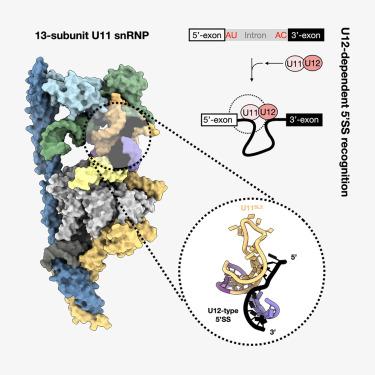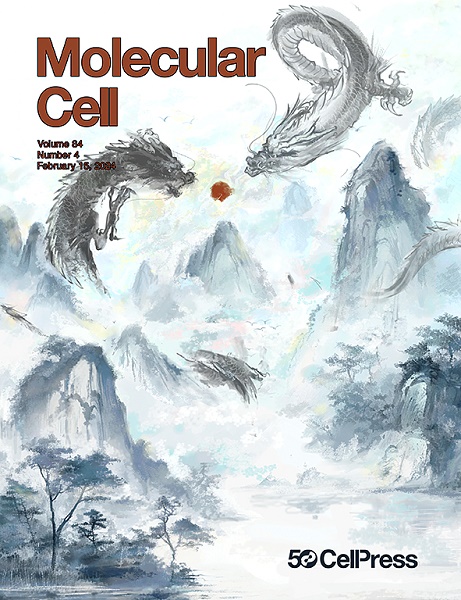小剪接体识别 5′剪接位点的结构基础
IF 14.5
1区 生物学
Q1 BIOCHEMISTRY & MOLECULAR BIOLOGY
引用次数: 0
摘要
小剪接体催化真核信使rna (pre- mrna)前体中u12依赖性内含子的切除。这一过程对许多细胞功能至关重要,但其潜在的分子机制仍然难以捉摸。在这里,我们报告了一个低温电镜(cro - em)重建的13亚基人U11小核核糖核蛋白颗粒(snRNP)复合物的载子和底物结合形式,揭示了U11小核RNA (snRNA)的结构,五个次要剪接体特异性因子,以及u12型5 ‘剪接位点(5 ’ ss)识别的机制。SNRNP25和SNRNP35特异性识别U11 snRNA,而PDCD7连接SNRNP25和SNRNP48,位于颗粒的远端。SNRNP48和ZMAT5位于U11 snRNA的5 ‘端附近,稳定了传入的5 ’ ss的结合。对u12型5 ‘ ss的识别是通过与U11 snRNA 5 ’端的碱基配对以及与U11 snRNA茎环3的非标准碱基三元相互作用实现的。我们的结构提供了对u12依赖性内含子识别和剪接机制进化的机制见解。本文章由计算机程序翻译,如有差异,请以英文原文为准。

Structural basis of 5′ splice site recognition by the minor spliceosome
The minor spliceosome catalyzes excision of U12-dependent introns from precursors of eukaryotic messenger RNAs (pre-mRNAs). This process is critical for many cellular functions, but the underlying molecular mechanisms remain elusive. Here, we report a cryoelectron microscopy (cryo-EM) reconstruction of the 13-subunit human U11 small nuclear ribonucleoprotein particle (snRNP) complex in apo and substrate-bound forms, revealing the architecture of the U11 small nuclear RNA (snRNA), five minor spliceosome-specific factors, and the mechanism of the U12-type 5′ splice site (5′SS) recognition. SNRNP25 and SNRNP35 specifically recognize U11 snRNA, while PDCD7 bridges SNRNP25 and SNRNP48, located at the distal ends of the particle. SNRNP48 and ZMAT5 are positioned near the 5′ end of U11 snRNA and stabilize binding of the incoming 5′SS. Recognition of the U12-type 5′SS is achieved through base-pairing to the 5′ end of the U11 snRNA and unexpected, non-canonical base-triple interactions with the U11 snRNA stem-loop 3. Our structures provide mechanistic insights into U12-dependent intron recognition and the evolution of the splicing machinery.
求助全文
通过发布文献求助,成功后即可免费获取论文全文。
去求助
来源期刊

Molecular Cell
生物-生化与分子生物学
CiteScore
26.00
自引率
3.80%
发文量
389
审稿时长
1 months
期刊介绍:
Molecular Cell is a companion to Cell, the leading journal of biology and the highest-impact journal in the world. Launched in December 1997 and published monthly. Molecular Cell is dedicated to publishing cutting-edge research in molecular biology, focusing on fundamental cellular processes. The journal encompasses a wide range of topics, including DNA replication, recombination, and repair; Chromatin biology and genome organization; Transcription; RNA processing and decay; Non-coding RNA function; Translation; Protein folding, modification, and quality control; Signal transduction pathways; Cell cycle and checkpoints; Cell death; Autophagy; Metabolism.
 求助内容:
求助内容: 应助结果提醒方式:
应助结果提醒方式:


